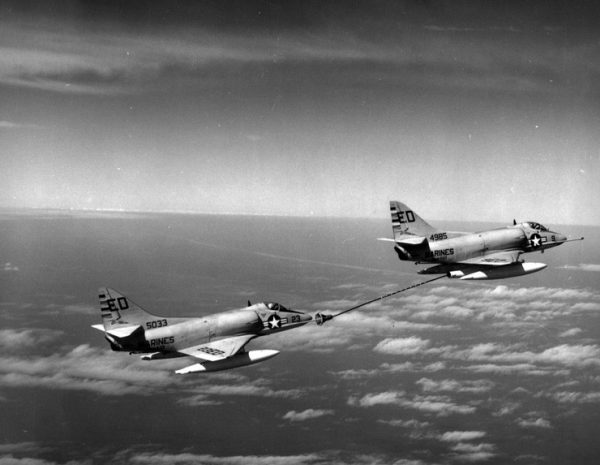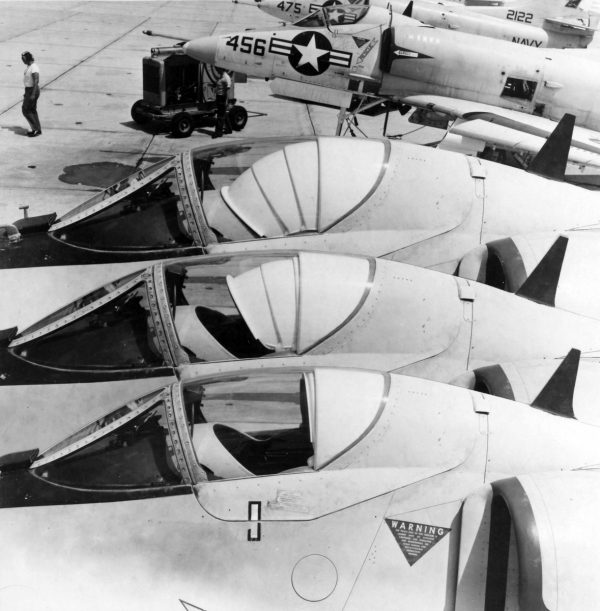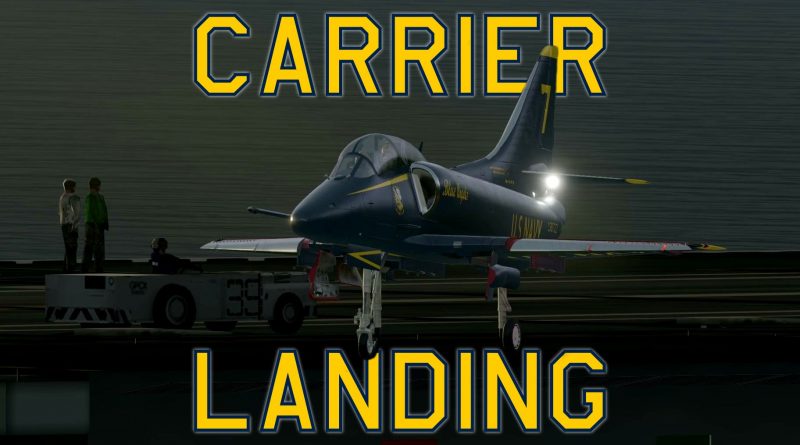Trapping a Skyhawk
In the latest episode of CHAIR FORCE, I flew a Blue Angels TA-4J Skyhawk from Naval Air Station Patuxent River to an aircraft carrier off the coast of Maryland. The video can be found below.
Naval aircraft were getting bigger and heavier in the 1950s, which is problematic when you have to squeeze around 100 planes and helicopters on a ship. The Navy wanted a replacement for the AD Skyraider and Douglas Aircraft Co.’s answer was the tiny A4D Skyhawk (later renamed A-4). The A-4 was so small it weighed less than half of what the contract allowed. Douglas designers found a lot of fat they could trim from attack aircraft, lightening or eliminating many components. Since the “Tinker Toy” was so small, it didn’t need heavy wing folding mechanisms. It also didn’t need hydraulic equipment to lower the landing gear — gravity did the job. It featured a wind-powered generator rather than heavy batteries. The delta-winged jet was fast, nimble, and cheap (well under $1 million each).
Before the Navy began using the KA-3 Skywarrior as a tanker, carriers would sortie an A-4 carrying only drop tanks it would use to refuel other Skyhawks. Pilots could carry a lot of weapons or a lot of fuel, but not both, so crews would load all the weapons the pylons would hold and then top up the tanks from their buddy after taking off. And the plane was so light that should the landing gear not come down, the Skyhawk could actually land on its drop tanks and be airworthy within an hour.

They were also versatile, being able to operate off small World War II-era flattops that bigger and faster jets couldn’t. They were widely used during the Vietnam War, and Skyhawk pilots logged more combat missions than any other aircraft with enemy fire shooting down 195 A-4s. 33 of them were lost on just one day — April 25, 1967. Surface-to-air missiles claimed 32 Skyhawks and one was shot down in aerial combat. The Navy phased out many of these light attack jets when the A-7 Corsair II entered the fleet, but A-4s made for great trainers and adversarial aircraft. TA-4J Skyhawks replaced the Grumman TF-9J Cougar as the main trainer, a job they did for the Navy and Marine Corps until they were phased out by the McDonnell Douglas T-45 Goshawk in service today.
The Blue Angels also adopted the A-4 for their demonstrations in 1974, replacing the F-4 Phantom II. The model I flew for the video was the Number 7 jet, a two-seat demonstrator model. The narrator for the Blues flies the No. 7 jet to shows, and will give a couple lucky local people a ride at each event. Plus, new team members ride in the back seat during practices to get used to the performance.
The Skyhawk’s career began back when the U.S. Air Force still had operational B-17 Flying Fortresses and lasted until 2003. Quick side note: the Air Force’s last B-17 (No. 44-83684) flew it’s final mission on Aug. 6, 1959, remotely piloting another B-17 that had been converted to a target drone which would be shot down by a Hughes AIM-4 Falcon missile near Holloman Air Force Base, N.M.
Eighth Air Force took delivery of 44-83684 the day before Nazi Germany surrendered to the Allies so it never flew in combat. Instead the plane become a movie star, appearing in ABC’s 12 O’Clock High series, NBC’s Black Sheep Squadron, and the movie The Thousand Plane Raid. It is now parked at the Planes of Fame aviation museum in Chino, Calif.
Speaking of Forts, the tiny Skyhawk could carry the same amount of ordnance as a B-17. It could also deliver nuclear weapons. To protect the pilot from the heat and bright flash of the nuclear blast designers came up with a deployable shield. On Dec. 5, 1965, an A-4E Skyhawk loaded with a B43 nuclear bomb was pushed off one of USS Ticonderoga‘s elevator and into the Philippine Sea. Crews were unable to recover the plane, pilot, and one-megaton weapon.

Nearly 3,000 airframes were produced before McDonnell Douglas shut down the line in 1979.
